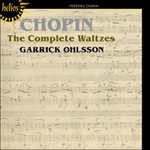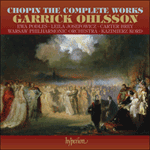
Welcome to Hyperion Records, an independent British classical label devoted to presenting high-quality recordings of music of all styles and from all periods from the twelfth century to the twenty-first.
Hyperion offers both CDs, and downloads in a number of formats. The site is also available in several languages.
Please use the dropdown buttons to set your preferred options, or use the checkbox to accept the defaults.
from notes by Gerald Larner © 2009
extrait des notes rédigées par Gerald Larner © 2009
Français: Hypérion
aus dem Begleittext von Gerald Larner © 2009
Deutsch: Viola Scheffel
 Chopin: The Complete Waltzes Chopin: The Complete WaltzesStephen Hough has a unique affinity for the music of Chopin, whose music has always been a central part of his repertoire. Hough’s name has become synonymous with pianistic elegance, flawless technique and immense musicianship and he has become gl ...» More |
 Chopin: The Complete Waltzes Chopin: The Complete Waltzes |
 Chopin: The Complete Works Chopin: The Complete WorksSince his triumph as winner of the 1970 Chopin International Piano Competition, Garrick Ohlsson has established himself worldwide as a musician of magisterial interpretive and technical prowess. This monumental recording project—first instigated by t ...» More |

